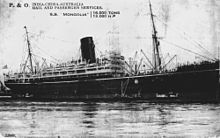
An ocean liner is a type of passenger ship primarily used for transportation across seas or oceans. Ocean liners may also carry cargo or mail, and may sometimes be used for other purposes. Only one ocean liner remains in service today.
Holland America Line is a US-owned cruise line, a subsidiary of Carnival Corporation & plc headquartered in Seattle, Washington, United States.

Swedish American Line was a Swedish passenger shipping line. It was founded in December 1914 under the name Rederiaktiebolaget Sverige-Nordamerika and began ocean liner service from Gothenburg to New York in 1915. In 1925 the company changed its name to Svenska Amerika Linien / Swedish American Line.

SS Southern Cross was an ocean liner built in 1955 by Harland & Wolff, Belfast, Northern Ireland for the United Kingdom-based Shaw, Savill & Albion Line for Europe—Australia service. In 1975 she was rebuilt as a cruise ship and subsequently sailed under the names Calypso, Azure Seas and OceanBreeze until 2003 when she was sold for scrap to Ahmed Muztaba Steel Industries, Chittagong, Bangladesh.

American Export-Isbrandtsen Lines, New York, was the leading US-flag shipping company between the U.S. east coast and the Mediterranean from 1919 to 1977, offering both cargo ship and passenger ship services, until it declared bankruptcy and was acquired by Farrell Lines of New York.
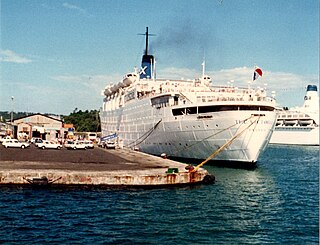
MS Dunnottar Castle was a British-built passenger ship with a career of more than six decades that included periods as an ocean liner, an armed merchant cruiser (AMC), a troop ship and several decades as a cruise ship. As a cruise ship she was renamed Victoria, then The Victoria and finally Princesa Victoria.

RMS Sylvania was an ocean liner built in 1957 by John Brown & Co (Clydebank), in Glasgow, for the United Kingdom-based shipping company Cunard Line. She was the last Cunard Line vessel built specifically for transatlantic crossings. The ship was later heavily rebuilt as a cruise ship, and sailed under the names SS Fairwind, SS Sitmar Fairwind, SS Dawn Princess and SS Albatros before being scrapped in 2004. She was renamed SS Genoa for her last voyage.
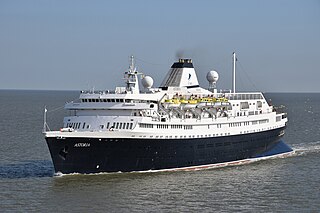
MV Astoria is a ship that was constructed as the transatlantic ocean liner Stockholm for Swedish American Line, and rebuilt as a cruise ship in 1993. Ordered in 1944, and commenced service in 1948, at 73 years old, she is the oldest passenger liner still sailing in deep water routes. As Stockholm, she was best known for an accidental collision with Andrea Doria in July 1956, resulting in the sinking of the latter ship and 46 fatalities off the coast of Nantucket, Massachusetts, United States.
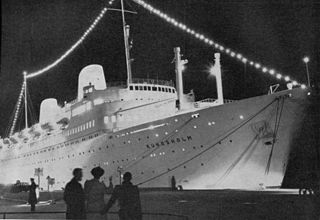
MS Kungsholm was a combined ocean liner / cruise ship built in 1953 by the De Schelde shipyard in Vlissingen, the Netherlands for the Swedish American Line. Between 1965 and 1981 she sailed for the North German Lloyd and their successor Hapag-Lloyd as MS Europa. From 1981 until 1984 she sailed for Costa Cruises as MS Columbus C. She sank in the port of Cadiz, Spain after ramming a breakwater on 29 July 1984. The vessel was refloated later that year, but sent to a Barcelona shipbreaker in 1985 for scrapping.
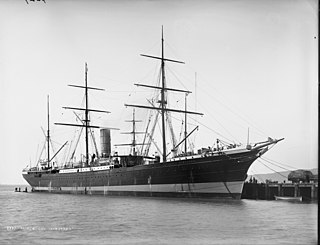
A number of steamships have been named the SS Rimutaka after the Rimutaka Mountains in New Zealand:

The SS Chusan was a British ocean liner and cruise ship, built for the Peninsular and Oriental Steam Navigation Company's Indian and Far East Service in 1950. She was named after Chusan, a small island off China. A smaller version of the SS Himalaya, the Chusan had a gross register tonnage of 24,215; and a capacity of 1,565 passengers and crew. She was built as a replacement for the RMS Viceroy of India, lost in the Second World War. She was 646.5 feet (197.1 m) long. The Chusan is said to have brought new standards of shipboard luxury to India and the Far East. She was the last passenger liner built for P & O by Vickers-Armstrongs.

The RMS Franconia was an ocean liner operated by the Cunard Line from 1922 to 1956. The liner was second of three liners named Franconia which served the Cunard Line, the others being RMS Franconia built in 1910 and the third Franconia in 1963.

SS Corinthic was a British passenger ship, built in 1902 by Harland & Wolff and launched for the British shipping companies White Star Line and Shaw, Savill & Albion Line. She was the second of the Athenic-class ocean liners built for passenger and cargo service between Britain and New Zealand. Her sister ships were SS Athenic (1902) and SS Ionic (1903).
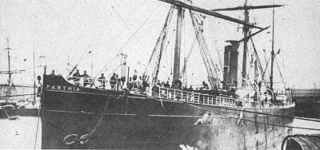
SS Parthia (1870–1956) was an iron-hulled transatlantic ocean liner built for the Cunard Line by William Denny and Brothers in Dumbarton, Scotland. Her sister ships were the Abyssinia and Algeria. Unlike her two sisters, Parthia was smaller, built in a different shipyard and had a slightly different funnel arrangement. The Parthia was retired by Cunard in 1883 and sold to John Elder & Co., who subsequently transferred her to the Guion Line. After serving with the Guion Line and operating on trans-Pacific routes with the Canadian Pacific Railway Company, she was refitted and renamed Victoria.

RMS Parthia was the second of two all first class transatlantic passenger cargo liners built for the Cunard Line. She later served on the London to Auckland route for the New Zealand Shipping Company under the name Remuera, and still later as a Pacific cruise ship under the name Aramac. She was scrapped in 1969–70.
SS Ruahine was a UK-built ocean liner and refrigerated cargo ship. She was launched in 1909 in Scotland for the New Zealand Shipping Company, who operated her in scheduled service between Britain and New Zealand. She survived both World wars.

SS Warrimoo was a passenger and refrigerated cargo liner that was launched in 1892 in England for Australian owners, was later owned by two of New Zealand's foremost shipping companies, and finally belonged to a Singaporean company.

SS Miowera was a passenger and refrigerated cargo liner that was launched in 1892 in England for Australian owners, and was later owned by two of New Zealand's foremost shipping companies. In 1908 her last owners renamed her Maitai. She was wrecked on a reef in the Cook Islands in 1916.

SS Veendam was a Dutch-owned transatlantic liner, launched in Scotland in 1922 and scrapped in the United States in 1953. She was part of the first generation of turbine-powered steamships in the Holland America Line fleet. Veendam and her sister ship Volendam were NASM's largest turbine steamships until the flagship Statendam was completed in 1929.

